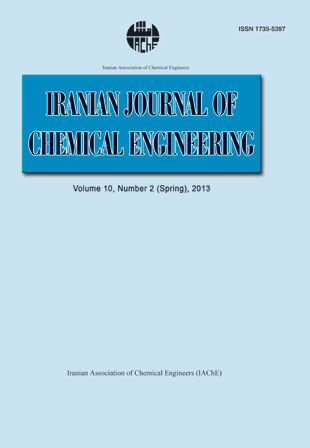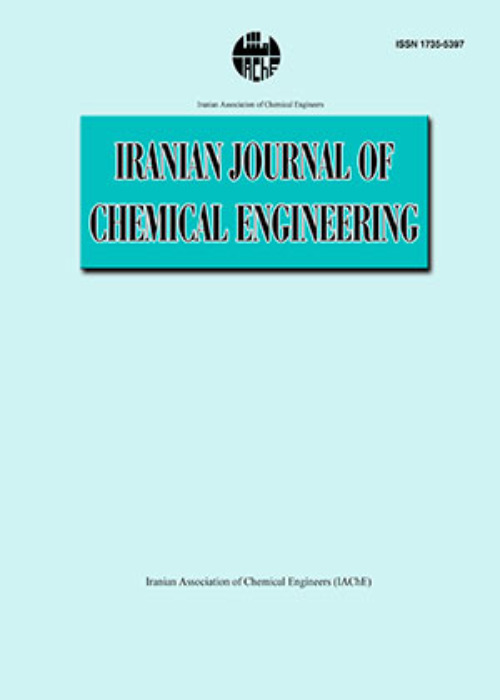فهرست مطالب

Iranian journal of chemical engineering
Volume:10 Issue: 2, Spring 2013
- تاریخ انتشار: 1393/02/24
- تعداد عناوین: 8
-
-
Pages 3-13
Sorghum bicolor L., a plant of Gramineae family is a perenial grass which is grown in many parts of tropical and warm temperates of the world. Sorghum seeds are rich in carbohydrates and can be used as fermentation medium providing it is produced through proper extraction and sacharification processes. In this study, the fermentation capacity of an aqueous or ethanolic extract from sorghum seed was investigated in Lab-scale bioreactors by using three selected Lactobacillus species including L. delbrueckii, L. acidophilus and a new isolated strain identified as a Lactobacillus sp. Among the selected bacterial species, Lactobacillus delbrueckii was found to have unique characteristics as it could tolerate different physico-chemical conditions. Compared to other species, L. delbrueckii could remain metabolically active in high concentration of NaCl and lactic acid, which is particular to the fermentation of sorghum seed extract neutrilized by NaOH. L.delbrueckii could also tolerate high temperature and, additionally, was able to produce more lactic acid in high concentration of carbohydrate during fermentation process (Yield 85-90%). In conclusion, the results of this study demonstrated that hydrolysed sorghum seed extract has enough nutrients to support the efficient growth of lactic acid bacteria and production of lactic acid under favorable conditions (37°C, 100 g/L initial carbohydrate concentration).
Keywords: Sorghum Seed, Lactic Acid Fermentation, Lactobacillus Sp., Saccharification, Growth -
Pages 14-21Heavy metal contamination of various water resources is of great concern because of the toxic effect on human being, other animals and plants in the environment. Concern over this problem has led to the development of alternative technologies for effecting the removal of these pollutants from aqueous effluents. Biosorption of cadmium (II) ions from aqueous solutions has been studied in a batch system by using a Bacillus sp. AEJ-89 (gram-positive) and Pseudomonas aeruginosa (gram-negative). Langmuir equation was based on the maximum rate of uptake of Cd (II) in Bacillus and Pseudomonas. The effects of various physicochemical factors on Cd (II) biosorption such as initial metal concentration, pH, and contact time were studied. This study has shown Cd (II) biosorption, equilibrium time of about 5 minutes for Pseudomonas and Bacillus about 10 minutes, respectively and the adsorption equilibrium data were well described by Langmuir equation. The maximum capacity has been extrapolated to 0/45, 0/85 mmol/g for Bacillus and Pseudomonas respectively. The gram positive bacterium showed more cadmium biosorption compared to the Gram-negative bacterium.Keywords: Cadmium, Pseudomonas Aeruginosa, Biosorption, Bacillus Sp. AEJ, 89, Iisotherms
-
Pages 22-32Biodegradation of a mixture of benzene, toluene, ethyl benzene, and o-xylene (BTEX) was studied in a two-bed biofilter. The packing material was a mixture of sugarcane bagasse and granulated activated carbon. Aspergillus Brasiliensis and Aspergillus Niger fungi were inoculated in the biofilter, separately. The effects of BTEX concentration, Empty Bed Residence Time (EBRT) and temperature on the biofilter efficiency have been studied. The results indicate that in the biofilter with Aspergillus Brasiliensis fungus, the removal efficiency approaches to 100% for the inlet load of 71.5 g.m-3h-1 and EBRT of 2.7 min while total removal efficiency in the biofilter with Aspergillus Niger fungus is obtained for the inlet load of 140.3 g.m-3h-1 and EBRT of 1.3 min. The maximum elimination capacity for this biofilter at inlet load of 223.08 g.m-3h-1 and EBRT of 0.9 min is 188.95 g.m-3h-1.Keywords: Biofilter, BTEX, Fungus, Bagasse, Aspergillus Niger, Aspergillus Brasiliensis
-
Pages 33-54Thermal cracking of light hydrocarbons was studied in which a molecular kinetic model for light hydrocarbons, and their mixture was developed. Required kinetic parameters were calculated and tuned by error minimization between several real reactors measured data and results of their simulation. Reactors were simulated as a one-dimensional plug flow reactor. Simulation consists of a reactor model and heat transfer from an external hot surface of the reactor. Nonlinear regression method was used to minimize the errors of simulation results and optimization of the kinetic model parameters. The kinetic and reactor models were verified by comparing their results with the measured data of several real reactors. Required experimental data were collected through the literature survey. Accuracy of the simulation results showed that the developed kinetic model and the reactor simulation can be applied for the operational analysis of cracking furnaces, operating parameters optimization, and industrial plant profitability improvement.Keywords: Thermal Cracking, Molecular Kinetic Model, Kinetic Parameters, Light Hydrocarbon
-
Pages 55-66Acidithiobacillus thiooxidans is an acidophilic chemoautotrophic type of sulfur-oxidizing bacteria. This microorganism lowers the pH of the medium to less than 1, and intensifies the degradation rate of cement-based structures. Growth of acidophilic bacteria on an agar solid medium does not lead to formation of colonies and thus counting of living cells is impossible in the process of cement biodegradation. In this study, the growth of two strains of A. thiooxidans (PTCC 1692 and PTCC 1717) were investigated using some liquid and solid culture media containing elemental sulfur and thiosulfate ion, in different conditions. Thiosulfate liquid culture medium with no ions similar to cement was the most suitable medium for the study of cement biodegradation. Several solid culture media containing agar and agarose were examined and the bacterial colonies were observed only on solid medium containing calcium, thiosulfate ions and agarose. To further our studies, the bacterial growth rate was evaluated on a 4-liter polypropylene bioreactor at temperatures of 25 and 30°C by two methods of continuous and alternating aerations at different rates. The highest growth rate was obtained in the 4th day of cultivation under aeration rate of 1 vvm for A. thiooxidans PTCC 1717 type strain.Keywords: Acidithiobacillus Thiooxidans, Cement Biodegradation, Solid Culture Media, Aeration
-
Pages 67-80The aim of this work is to model the vibration of the shell of a cylindrical fluidized bed under internal pressure fluctuations in order to predict its hydrodynamic behavior. Pressure fluctuations of gas-solid were calculated by a CFD-DEM model. The governing vibration equations of the shell were derived from Donnell’s nonlinear shallow-shell theory. The discretized equations were obtained by Galerkin’s method and solved with the finite element analysis. Results of the model were compared with the experimental data in both time and frequency domains.It was shown that the model is able to follow the trends of standard deviation, skewness and kurtosis of the vibration signals obtained from experiments. Minimum fluidization velocity was calculated from standard deviation, skewness and kurtosis of vibration signals. It was shown that the dominant frequency of vibration signals is around 1500-2000 Hz in bubbling fluidized bed and there is a good agreement between the power spectrum density of the simulated and experimental vibration signals. The results showed that the vibration model developed in this work can simulate the real dynamic conditions of the bubbling fluidized bed and is a reliable method to predict the hydrodynamic behavior of the bed.Keywords: Fluidized Beds, Vibration Modeling, CFD, DEM, Circular Cylindrical Shell
-
Pages 81-86Zinc oxide nano wire have been produced by simple thermal way heating Zn powder on alumina substrate at different temperatures from 600C to 1000C in furnace for a time period of 30 minutes under oxygen gas environment. The prepared samples were characterized by different characterizing techniques, scanning electron microscopy (SEM), X- ray Diffraction (XRD), energy dispersive X-ray spectroscopy (EDS), UV-Visible spectroscopy.In all photographs it is clearly seen that the growth of nano wires is initiated at outer surface of the ZnO porous grains. The growth is clearly started at the edge of the surface.The XRD characterization confirms the wurtzite hexagonal structure of synthesized zinc oxide.The band gap of synthesized semiconductor Zinc Oxide is increased rather than the bulk Zinc Oxide.Keywords: Zinc Oxide Nano Wire, Thermal Way Heating, Characterization
-
Page 87


